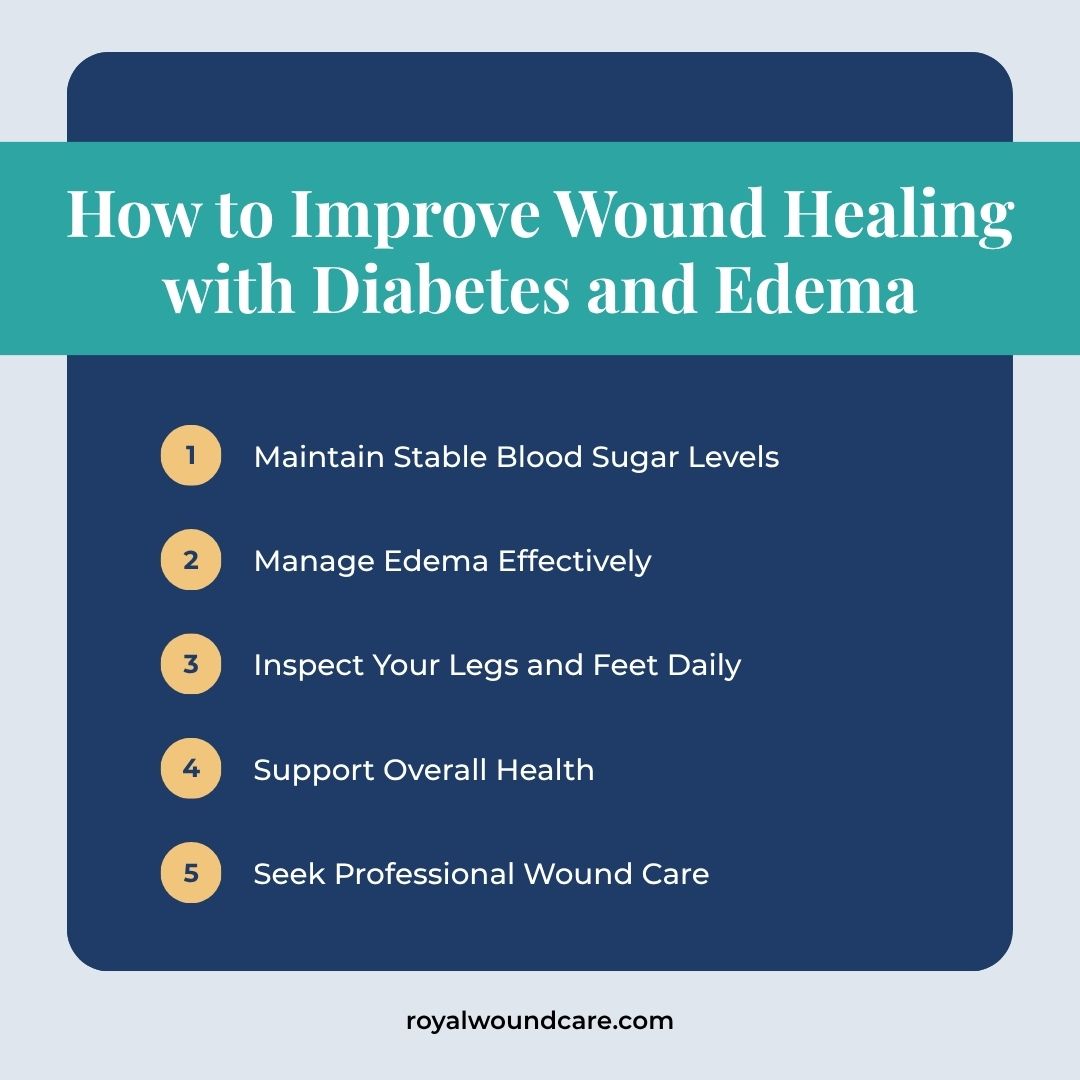In-Clinic Wound Care Services
Expert Wound Management in a Safe, Sterile Environment
In-clinic wound care offers patients a higher level of treatment that goes beyond what can be managed at home. With access to specialized equipment, advanced therapies, and a dedicated wound care team, patients receive personalized care tailored to their specific wound type and medical history.
Regular in-clinic visits allow for close monitoring, faster adjustments to treatment plans, and early detection of complications—leading to quicker healing and fewer hospital visits. For patients seeking expert care in a safe, professional setting, in-clinic wound care provides peace of mind and better outcomes.
Why Choose In-Clinic Care?
Sterile
Setting
Controlled environment to minimize risk of infection.

Advanced Equipment
Access to diagnostic tools and specialized wound care
technology.

Integrated Care
Opportunity to manage underlying conditions
and your wound in one office visit.

Ongoing Monitoring
Consistent follow-ups and progress tracking for faster healing.

Immediate Access to Care
Faster procedure, consultation, and treatment access without mobile or home service delays

About Wound Care Awareness
This annual campaign began in 2014 when we recognized that nearly 7 million
Americans have a non-healing wound. Lack of awareness leads to fewer screenings,
limited interventions and wounds that can progress to severe complications or even
amputation.

Edema and Diabetes and Slow Healing Wounds: Understanding Care
Edema and Diabetes and Slow Healing Wounds: Understanding Care
Slow wound healing can be caused by various factors, such as age, poor circulation, certain medications, and underlying health conditions. Among these, diabetes is one of the most common culprits.
When a nurse or patient is managing wound healing in diabetes, they have to consider high blood sugar levels, neuropathy, an impaired immune system, and edema. Additionally, diabetes significantly increases the risk of developing chronic wounds. If left untreated, these may lead to infection, tissue damage, or the need for surgical intervention.
A deeper understanding of how diabetes and edema impact wound healing can make all the difference in recovery. Today, we will explore the connection between the two and discuss the steps nurses and patients can take to help heal wounds more effectively.

Edema and Diabetes and Slow Healing Wounds: Understanding Care
The team at Royal Wound Care understands the complexity of diabetic wounds. This is why we offer specialized treatment to prevent infections, reduce the risk of hospitalization, and promote faster healing.
Just as important, though, is understanding why these challenges happen—like how edema and diabetes can slow wound healing. In today’s post, you can expect to learn about how diabetes impacts the healing process, why edema can slow wound repair, and the specific reasons wounds heal more slowly with both conditions.
Most importantly, our goal is to provide clear, evidence-based guidance for enhancing wound healing when managing diabetes. Whether you’re a patient, nurse, or SNF, the right care and knowledge are essential for achieving optimal recovery.
Does Diabetes Slow Wound Healing?
Yes, diabetes can significantly slow the wound healing process. High blood sugar levels can impair the immune system, increase inflammation, and damage blood vessels—all of which make it harder for the body to repair itself.
When blood vessels are compromised, it takes longer for essential nutrients and oxygen to reach the wound site. This can both slow healing and increase the risk of infection. In some cases, patients may also develop diabetic neuropathy, or nerve damage, which can reduce sensation in the extremities.
Without normal sensation, even minor injuries can go unnoticed, leading to chronic, slow-healing diabetic wounds. With attentive care and proper management, however, you can support healing and minimize complications.
Related: How Long Does It Take for a Wound to Heal?
Does Edema Slow Wound Healing?
Yes, edema, or swelling caused by fluid accumulation, can also lead to slower wound healing. When fluid accumulates in the tissue, it restricts blood flow and reduces the delivery of both oxygen and nutrients. This creates an environment that is unsustainable for wounds to heal effectively.
Excessive swelling can also put extra pressure on the body, which may contribute to tissue damage if left unaddressed. For individuals with a weakened immune system, proper wound care and early intervention are even more important.
Related: When to See a Wound Care Specialist: Signs It’s Time to Get Expert Help

Why Do Wounds Heal Slower with Diabetes and Edema?
Poor Circulation
People with diabetes often experience damage to their blood vessels over time, partly due to high blood sugar levels. This can make it harder for blood to flow smoothly, contributing to blockages, nerve damage (peripheral neuropathy), and reduced circulation.
Because edema causes fluid retention, the resulting pressure can further limit blood flow, making poor circulation even more challenging. When circulation is impaired, it becomes more difficult for the body to deliver oxygen and nutrients it needs for tissue repair.
This is often where patients struggle with chronic, non-healing wounds, such as leg or foot ulcers, that can become painful and prone to infection. However, the team at Royal Wound Care offers comprehensive diabetic foot ulcer care to support recovery and improve outcomes.
Related: Managing Chronic Wounds: A Comprehensive Guide
Nerve Damage
As we mentioned above, it’s not uncommon for diabetic patients who are also dealing with edema to experience nerve damage. However, neuropathy is far more than a reduced sensation in the hands and feet. It can also make it difficult to notice cuts, blisters, or pressure points.
Even minor scratches can develop into larger, more serious wounds if they go unnoticed. Without timely care, these injuries can quickly turn into diabetic foot ulcers, which are prone to infection and slow healing.
Related: Advanced Wound Treatments
Fluid Buildup and Swelling
People with diabetes can develop edema, or fluid retention, for a variety of reasons. A few examples are kidney damage, poorly controlled blood glucose levels, certain medications, and lifestyle factors.
However, edema isn’t just uncomfortable—it can stretch the skin and soft tissues, making them more susceptible to injury and infection. Additionally, it impairs blood and oxygen delivery, making it harder for nutrients to reach wounds and heal them effectively.
Impaired Cell Function
The body relies on countless cells to support optimal healing. Keratinocytes help rebuild the skin’s surface, fibroblasts are essential for forming new connective tissue, and endothelial cells regulate blood flow to injured areas.
However, in diabetes, especially when edema is present, swelling and reduced nutrient delivery can interfere with the cells’ functions. When cells aren’t able to work effectively, wounds heal more slowly—or sometimes not at all without proper wound management.
Weakened Immune System
Diabetes can weaken the immune system through chronic inflammation and reduced white blood cell function. When combined with edema, impaired circulation makes it more difficult for immune cells to reach the wound, thereby slowing the body’s ability to fight infection and repair tissue.
As a result, patients then experience chronic immune system stress. Rather than everything working fluidly, the body essentially works overtime, leading to a weakened immune response. When the immune system can’t respond appropriately, even minor cuts and scrapes can progress into chronic wounds with longer healing times.
High Blood Sugar Levels
At the core of diabetes is an imbalance in blood sugar levels. When these levels remain consistently high, it can contribute to the development of edema. In turn, this affects circulation, weakens the immune system, and impairs cellular function.
As we discussed above, these factors can make even minor cuts or scrapes slower to heal. And, if not managed carefully, these injuries can progress into chronic, non-healing wounds.

How to Improve Wound Healing with Diabetes and Edema
Maintain Stable Blood Sugar Levels
Controlling blood sugar levels is the foundation of proper wound healing in diabetes. When blood sugar levels are high, especially on a regular basis, it impairs the body’s ability to heal naturally.
On the other hand, maintaining blood sugar improves blood flow and circulation, allowing oxygen and nutrients to reach wounds promptly. This reduces the risk of infection and results in faster, more sustainable healing.
Manage Edema Effectively
The better a patient is able to manage edema, the better their chances are of healing wounds and fighting off infections. To help with this, encourage consistent elevation, compression therapy (if approved by a provider), and gentle movement.
Additionally, at Royal Wound Care, we encourage patients to keep wounds moist and protected. The same standards apply to caring for edema. Dry and swollen skin is more prone to cracking, breaking, and developing wounds. Moisturizing regularly and avoiding extreme temperatures is the key to safe wound management.
Related: Caring for Your Wound
Inspect Your Legs and Feet Daily
For people with diabetes, regular self-checks are important. Look for any signs of redness, swelling, cracks, or skin stretching. If you notice anything abnormal, clean the area, moisturize the skin, and protect the area from bacteria and pathogens. Early detection also helps prevent complications and an increased risk of infection.
Support Overall Health
Managing your health with diabetes can often take extra time, attention, and effort. However, with the right strategies and proactive steps, you can effectively support your overall health and well-being.
Aside from successfully tracking blood sugar, make sure your lifestyle aligns with optimal healing. For example, focus on eating a balanced diet, incorporating physical activity throughout your day, limiting your salt intake, and staying hydrated. The right approach can easily support slow healing wounds during recovery.
Related: Nutrition and Wound Healing: Expert Strategies
Seek Professional Wound Care
Even minor wounds can feel hard to manage. However, a board-certified specialist can evaluate any injury and recommend proper treatment plans to increase the rate of healing. At Royal Wound Care, we pride ourselves on providing the highest level of wound management—from diagnosis to resolution.
Through cutting-edge research, advanced treatments, and a highly trained staff, patients can experience reduced hospitalizations, lower infection rates, and faster healing times. We aren’t just here to support you—we’re here to lead you to safe, optimal, and effective recovery.
Visit our site today to learn about our Mobile Wound Care services, In-Clinic Wound Care services, and home health care.
Edema and diabetes can result in slow healing—but the right strategies and treatment plans can help wounds recover more effectively.
80,000 adults with diabetes and edema undergo amputations every year due to non-healing wounds. While this number may feel staggering, most wounds heal successfully with proper care. By staying proactive, monitoring for any changes, and following expert guidance, patients can prevent life-threatening complications and better support recovery.
If you need help managing diabetic wounds, get in touch with Royal Wound Care today! We encourage you to call with any questions or concerns you may be experiencing. Remember: healing doesn’t have to be hard—you just need the right team behind you.
For SNFs or independent nurses, we offer advanced education opportunities and professional partnerships to support better patient care. Through transforming how wound care is delivered, it’s time to reset the standard in healing excellence.
Resources for People with Non-Healing Wounds
Your ability to heal can be affected by diabetes, heart disease, cancer or other immune-compromising health conditions.
Learn more about who is at risk and how to prevent wounds with our educational resources.
WEST HILLS
7230 Medical Center Dr. Suite 100
West Hills, CA 91307
(818)–660–2977
BEVERLY HILLS
9735 Wilshare Blvd #210B
Beverly Hills, CA 90212
(818)–660–2977
If you are interested in making an appointment, please click here to find a Wound Care Center near you.
Request an Appointment at a Royal Wound Care Facility near you.
Royal Wound Care is the expert in wound healing. Our board-certified wound care specialists are ready to help you begin your healing journey. Click the button below to request an appointment at a Wound Care Center near you—no referral needed
© 2025 Royal Wound Care, LLC. All rights reserved.
site by Growth Partners Marketing

